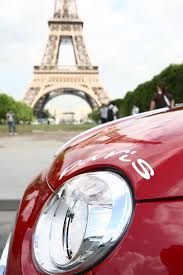
In the run-up to the Paris Motor Show which opens its doors to the media later this week, several automakers are still holding back details of forthcoming reveals. Here, IHS Automotive will highlight some of its expectations for some key models that will be unveiled in the coming days.
Land Rover Discovery
Although Jaguar Land Rover (JLR) has teased the fifth-generation Land Rover Discovery sport utility vehicle (SUV) with two images of its frontal aspect, it is only due to reveal full details on 28 September, prior to the event opening. The images show a vehicle that shares its looks with the Discovery Sport which has successfully replaced the Land Rover Freelander, while the brand’s chief design officer, Gerry McGovern has said, “New Discovery redefines the large SUV. Land Rover’s design and engineering teams have revolutionised the Discovery DNA to create a highly desirable, extremely versatile and hugely capable premium SUV.”
This will be the latest model in Land Rover’s range to benefit from a wholesale update, and while it will have some of the characteristics of the current generation – such as the ability to carry seven occupants – it will be the first wholesale change in body design in 12 years. This vehicle is expected to be far lighter than the current generation as it makes the transition from the T5 to the aluminium PLA-D7u architecture that already underpins the Range Rover and Range Rover Sport. Furthermore, IHS Automotive expects its engine range to benefit from downsized offerings, including 2.0-litre four-cylinder gasoline (petrol) and diesel variants of its Ingenium engine range, as well as 3.0-litre six-cylinder gasoline and diesel variants. This is also expected to be a plug-in variant within the next couple of years of its launch. We anticipate that production will initially begin at Solihull (United Kingdom) but will eventually take place in Nitra (Slovakia) before the end of the decade. We also expect that this model’s global sales will peak at around 59,000 units in 2018, outperforming the previous generation’s peak of over 52,000 units in both 2005 and 2015. IHS Automotive anticipates that around 30% of this new generation will be sold in European Union (EU) and European Free Trade Agreement (EFTA), 27% in China and 17% in North America.
Audi Q5
Audi has also recently hinted at its forthcoming second generation Q5 in recent days via a countdown clock on the brands media website. It has also released videos showing the new light technology which will be available, hinting at the connectivity options with Apple and Android devices as well as the greater availability of luggage space in this new vehicle . The company is already seeking to create a social media buzz around this vehicle with the hashtag #Qriosity.
Despite the lack of information, the styling is set to ape that of the latest generation Audi Q7, with its large chrome edged grille according to images that have been leaked and rendered from these teaser videos. The vehicle will use the MLB B/C architecture which underpinned the previous generation Q5 as well as the A4, A6, A7 and the A5/A5 Sportback, the second generation of which is also making its appearance at this event. IHS Automotive also anticipates that its engine range will be made up of turbocharged gasoline and diesel 2.0-litre four-cylinder and 3.0-litre V-6 engines. The new Q5 will leave its Ingolstadt (Germany) headquarters to be produced in a new San Jose Chiapa (Mexico) plant, alongside existing manufacturing locations in Changchun (China) and Shendra (India). IHS Automotive anticipates that global sales of this new generation vehicle will peak in 2018 at almost 275,000 units, which would be a slightly stronger performance than the first generation’s peak. Of this total, around 46% will be sold in Greater China, 23% sold in North America and 22% in EU+EFTA.
Nissan Micra
The new B-segment Nissan Micra is also on course to be unveiled at this event. Although the automaker’s senior management have indicated that this will be a far more sophisticated vehicle than the current generation, little more has been given in terms of what we may expect. However, recently the automaker has released a video giving an indication as to the design of the vehicle which shows a vehicle that appears to draw very heavily from Nissan’s Sway concept shown at the Geneva Motor Show (Switzerland) during 2015. This also uses the tag line of “A Revolution is Coming.”
This model will make a shift from the V platform to Renault-Nissan’s modular CMF-B architecture, and it will be one of the initial vehicles to benefit from new flexible platform. However, it will be eventually be joined by the Japanese automakers Juke and Note; Renault’s Clio and Captur; Dacia’s Sandero, Logan and Duster, and even future AvtoVAZ model during the next decade, which will all help to grow volumes sold off this platform to over 4.5 million units per annum (upa) within the next decade. The new Micra – to be known as March in some global markets – will again be built at sites at Resende (Brazil), Guangzhou (China), Oragadam (India), Agualiscalientes (Mexico) and San Yi (Taiwan). However, vehicles built for European sale will now be manufactured at Renault’s site in Flins, near Paris (Paris). Powertrain options will depend on market demands, although IHS Automotive anticipates that these will include a range of gasoline engines in naturally aspirated and supercharged derivatives, as well as a 1.5-litre diesel. We anticipate that peak sales of the Micra/March will stand at 233,000 units by 2020, although registrations in EU+EFTA will peak at around 100,000 units during 2018. Other key markets for this model will be North America, South America, India and China later in its life.
VW EV concept
VW’s electric vehicle (EV) concept is likely to be one of the hot topics of the event given that it is little over a year since its diesel emissions saga began. This unveiling also underlines the revision of the wider VW Group’s strategy which was revealed in June. In a previous statement, the company has said that that this “design study” is a “one-of-a-kind concept car” which “is as revolutionary as the Beetle was seven decades ago before it evolved into the world’s best-selling car of the century.” Certainly the sketches indicate a vehicle that is approximately Golf-sized but with futuristic and stylish front and rear graphics. The car is likely to feature distinctive styling that will give the production C-segment EV its own unique visual appearance to distinguish it from other vehicles in its range.
VW has also added that the “production vehicle which follows will be the first Volkswagen to hit the market based on the new modular electrification kit [MEB].” The MEB architecture is one of the key pillars of its EV strategy which is intended to eventually see the launch of over 30 battery-electric vehicles (BEVs) during by the end of 2025, which according to the company will make up 2–3 million units of its global sales by then, equivalent to 20–25% of its overall sales. However, there has been little clarity as to whether MEB is a new architecture though. Indeed, given the amount of investment that it has made into the technology and manufacture of its compact MQB architecture – underpinning models such as the VW Golf and Tiguan to name but two – and the huge gamble that throwing the automaker weight behind this technology would be, it may well be that this is a derivative of MQB. This could ensure that MEB-based vehicles could easily use existing plants, and production numbers could be adjusted as demand for the technology grows.
Outlook and implications:
Although these vehicles remain under wraps, there is at least a certain amount of clarity as to whether they will make an appearance. However, there are others which are still being cagey and it we may need to wait until the event itself before confirmation is received. This includes an EV concept from Mercedes which is reportedly to be shown, which is thought to have some crossover overtones. BMW is also said to be planning to show a concept that is said to hint at its forthcoming X2 crossover, which may also leverage EV powertrain technology. Nevertheless, automakers have already confirmed that they will show vehicles that will support the current trend for crossovers and SUVs, as well as the demands from legislators for greater numbers of electrified vehicles.














More Stories
Automechanika Shanghai 2024
A successful and promising fresh start for the Geneva International Motor Show 2024
Vega’s Innovative Transportation Solutions: Revolutionizing the Logistics Industry